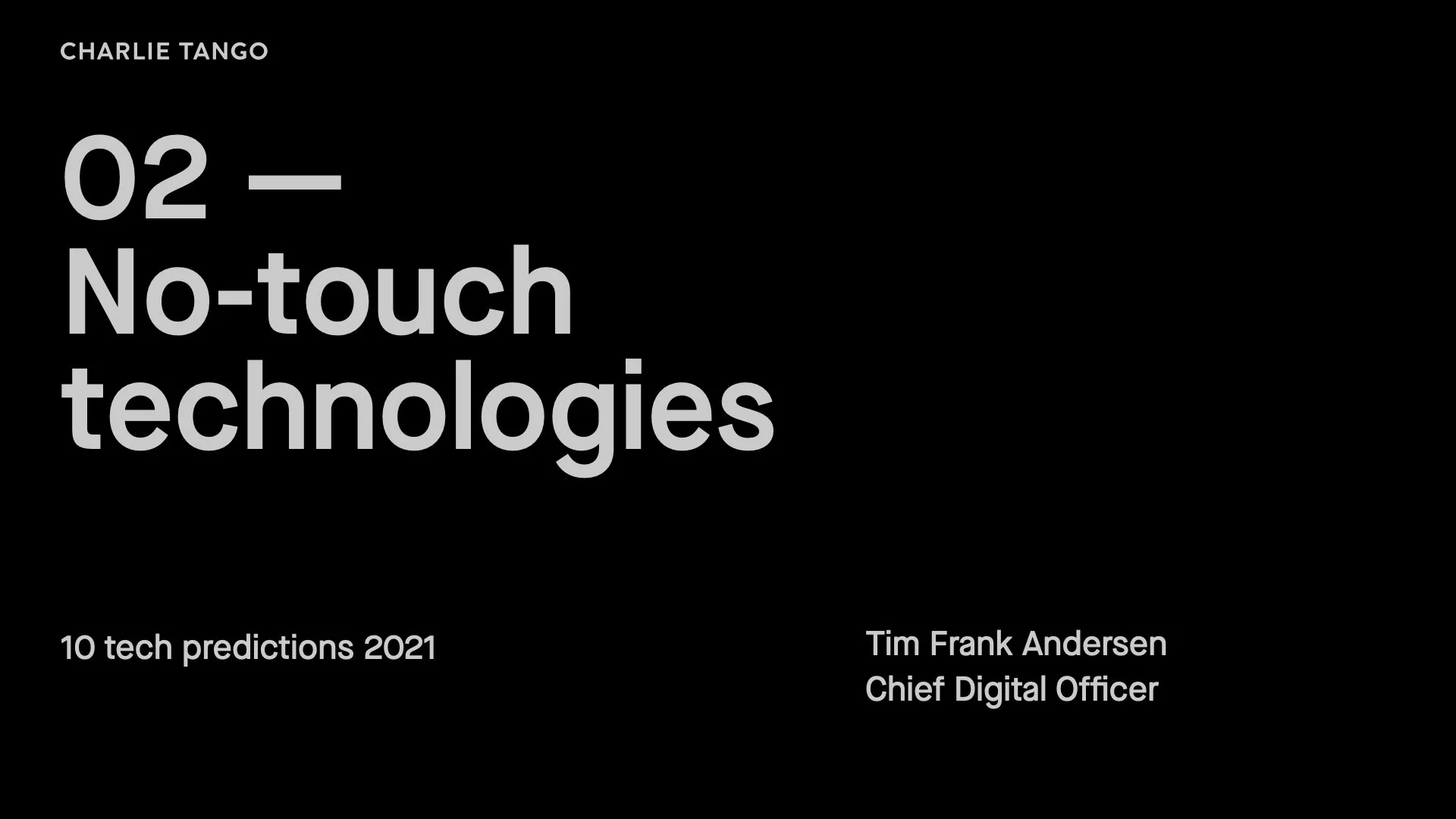No-touch technologies
During the pandemic we learned to avoid all kinds of unnecessary contact — physical cash, door handles and point of sale card terminals — to reduce the chances of infection. But it can be difficult in the screen-tapping, button-pushing society that we have created.
Luckily, this has paved the way for a boost in no-touch technologies of all kinds.
Speech recognition has improved dramatically over the last few years, even for a small language like Danish. The Google Nest Hub is a great example of a touch-eliminating helper for your home. In US, Exxon has implemented Amazon´s new voice-based “Pay for gas” solution directly at the pump at more than 11,000 gas stations.
But imagine going into an elevator saying: “5th floor please” instead of pushing a dubious button or getting stuff from a vending machine just by speaking to it. And the payment is handled by looking into a camera and “paying with a smile”.
Biometric solutions, like facial recognition, is another technology that eliminates all kind of touching — from gaining access, opening doors or getting through security and passport control at the airport. And, of course, authenticating yourself in a payment situation.
Since we have been practically unable to use physical money for ten months, digital payment solutions of all kinds, and wallets like Apple Pay, Samsung Pay and Google Pay, have all experienced huge growth in 2020 — and the change in behavior doesn´t seem to be temporary, because none of us wants to hand over or receive cash or credit cards anymore. The total transformation has already happened in China, where 95% of all transactions are done through touchless mobile payments by using a low-tech solution, QR codes, or a biometric solution like “pay with a smile”.
In our part of the world, we will stick to credit cards for a while, due to the successful roll-out of contactless payments in stores, but if the amount is above 350 dkk, you still have to punch in your pin code.
A new kind of biometrically enhanced payment card solves this problem. Integrating a fingerprint scanner directly on the payment card provides several benefits beyond ease of use:
Stronger security: The fingerprint biometric is stored only on the card to ensure that a cardholder’s data is protected.
Unnecessary hardware upgrades: The biometric card is designed to be compatible with already existing payment terminals that accept contactless or chip-based payments around the world.
Self-charging: The biometric sensor is powered by the payment terminal, ensuring there is no embedded battery or need to recharge the card.
Biometric payment cards have reached several important milestones in the last year. The technology has achieved certification from major payment networks, the cost of the technology has come down, and manufacturing has become simpler.
A fingerprint scanner implemented directly on your credit card
The first commercial biometric payment cards have now been issued in France, powered by the technology company Thales and Swedish biometric company Fingerprint. The biometric payment card fits a new post-COVID-19 contactless paradigm perfectly. So, expect to see a wider roll-out in Europe during 2021.
But when customers don´t want to come to you, you have to be innovative:
WeltMeister cars, a new energy vehicle startup in China, shifted their customer approach to a “zero-touch” sales strategy during Corona, allowing potential new buyers to design the car interactively while live streaming with salespeople and then order a test drive delivered directly to their home. The results were great: on launch day more than 3,000 put down the deposits for the new 2020 model.
Another startup, Moviebill, which usually makes great AR experiences for cinemas, pivoted their business to focus on in-flight AR solutions for things like safety cards, duty-free magazines, and inflight menus. So, airlines can get rid of these potential infection sources and passengers can access documents directly on their phone by scanning a code or just the airline logo.
Healthcare solutions are also being developed. The Danish company UVD Robots has developed a fully autonomous hospital-grade disinfection robot that cleans everything from hospitals, offices, hotels, airports, cruise ships, and shopping malls without human interaction. And without chemicals — just using UV-C light, it is able to kill almost 100% of all bacteria and viruses just by driving by.
UVD Robots disinfections hospitals without touching anything — just using ultraviolet light
From a consumer point of view, the newest generation of smartphones from Huawei (Honor Play 4 pro) comes with a built-in infrared sensor that lets you measure your temperature without touching, so you can check for fever on the go.
A built-in infrared sensor that lets you measure your temperature without touching
And the list of examples goes on. I predict a great future for all technologies that will reduce friction and fear by removing the need for physical contact.
So now is the time for you to consider how you can eliminate touch in your product or service by using these new technologies.





